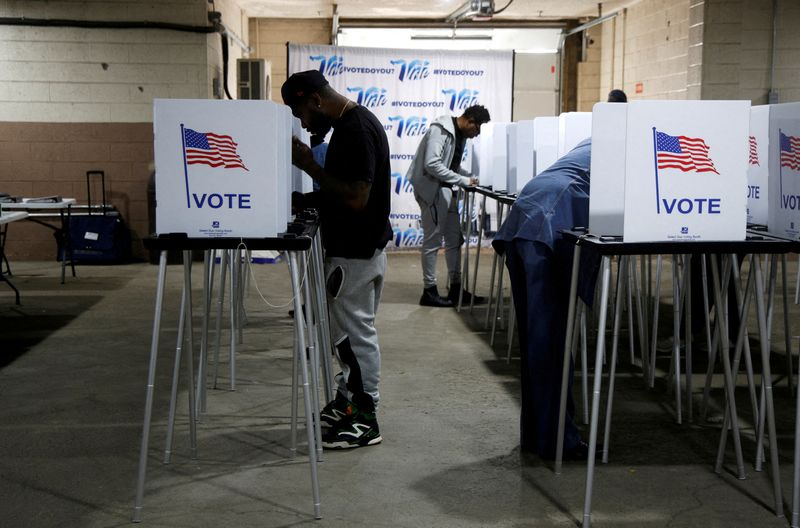
(Reuters) - The race between Republican Donald Trump and Democrat Kamala Harris has divided the U.S. electorate along lines of gender, race and education, with Trump improving his standing among men - particularly Hispanic men - while Harris' support has surged among women, helping her cut away at the Republicans' longstanding edge with white voters.
The following figures draw from an analysis of more than 14,000 responses by registered voters in Reuters/Ipsos polls conducted in October of this year and in the same month of 2020. The numbers have levels of precision between 2 and 6 percentage points. * Among women, Harris led Trump this month by 12 percentagepoints: 50% to 38%. By comparison, Biden led Trump by 5 pointsamong women voters in October 2020. Some respondents in thepolls said they were unsure how they would vote, or that theymight pick a third-party candidate or not vote at all. * Democrats' gains among women have been fueled by Harris'standing among white women. Harris trailed Trump by 2 pointsamong white women- 46% to 44% - a much smaller margin than the16-point lead Trump had over Biden four years earlier. * Among men, Trump led Harris by 7 points: 48% to 41%. Aheadof the 2020 election, Trump was leading Biden by 1 point: 45% to44%. * Trump's improved standing with male voters was driven inpart by his gains among Hispanic men. Trump was trailing Harrisby just 2 percentage points among Hispanic men - 46% to 44% -compared with his 16-point deficit with Biden - 53% to 37% - atthe same point in 2020. * Hispanic voters, the fastest-growing segment of the U.S.electorate, have leaned heavily Democratic in most presidentialelections since the 1970s but Trump has made significantinroads. Trump had the support of 38% of registered Hispanicvoters, up from 32% at the same point in 2020. Harris' share ofHispanic voters was at 50%, compared with Biden's 54% in October2020. * Among Black voters overall, 68% said they would vote forHarris, down from 74% who said in October 2020 they would votefor Biden. Trump only gained marginally - he was picked by 12%of Black voters this month compared to 11% four years ago. Theshare of Black voters who said they wouldn't vote was upslightly, 7% in October of this year compared to 3% just beforethe 2020 election. * The share of Black men saying they would vote for Harris -63% - was down 8 points from Biden's 71% ahead of the 2020election. The share of Black women picking Harris was down 4points to 73% from the 77% who said they would vote for Biden inOctober 2020. * Some 19% of Black men and 7% of Black women said inOctober they would vote for Trump, up from 17% and 5% who saidthe same in October 2020. * Harris' 21-point lead among Hispanic women - 53% to 32% -was tighter than Biden's 31-point lead - 56% to 25% - amongHispanic women in October 2020. * Trump was the pick of 50% of white voters overall, downfrom 53% in October 2020. Some 40% of white voters pickedHarris, up from 35% who said they would vote for Biden inOctober 2020. Harris' gains were mostly fueled by her advanceamong white women, though she advanced slightly among white menas well. Trump's 18-point lead over Harris among white men - 54%to 36% - was narrower than his 20-point lead four years ago. * Among voters without a college degree, Trump led Harris inOctober by 10 points - 49% to 39% - after leading Biden by 2points four years earlier - 44% to 42%. * College graduates - who make up a smaller share of theelectorate but tend to participate more in elections - werebreaking more heavily Democratic, with Harris leading Trump by21 points - 55% to 34% - compared with Biden's 9-point lead inOctober 2020.